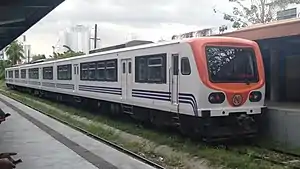PNR Hyundai Rotem DMU
The PNR Hyundai Rotem DMU is a class of diesel multiple units (DMUs) operated by the Philippine National Railways since 2009.
| PNR Hyundai Rotem Diesel Multiple Unit | |
|---|---|
 DMU-05 with its new livery in January 2020. | |
| In service | 2009–present |
| Manufacturer | Hyundai Rotem |
| Replaced | JNR 12 series coaches CMC class DMU (decommissioned 2004) |
| Entered service | June 2009 |
| Number built | 18 vehicles (3 cars per trainset) |
| Number in service | 12 vehicles (4 trainsets) |
| Formation | 3 cars per trainset |
| Fleet numbers | DMR-01 to DMR-12 ITR-01 to ITR-06 |
| Capacity | 502 passengers[1] |
| Operator(s) | Philippine National Railways |
| Depot(s) | Tutuban Depot |
| Line(s) served | PNR Metro Commuter Line |
| Specifications | |
| Car body construction | Stainless steel |
| Car length | 20,800 mm (68 ft 3 in)[1] |
| Width | 2,850 mm (9 ft 4 in)[1] |
| Height | 4,060 mm (13 ft 4 in)[1] |
| Doors | 2 double-leaf doors per side |
| Maximum speed | 110 km/h (70 mph)[1] |
| Weight | Approx. 100 t (220,460 lb) |
| Power supply | 380V AC, 24V DC |
| Coupling system | Janney Coupler |
| Track gauge | 1,067 mm (3 ft 6 in) |
Overview
The train was introduced as the first lightweight, stainless steel made trainsets of the PNR in 2009. The trains are made up of 6 sets (18 vehicles). Plans were made for the possible upgrade of the trains in 2011, however, due to the procurement of the 203 series as the new main vehicles, the plan was scrapped.
The trains have 2 double-leaf, sliding doors per side, with the seats of the trains made up of Fibre-reinforced plastic.
Operations
The train was first unveiled on June 15, 2009 and was labeled "PNR Filtrack." It was used on the Metro Commuter Line running from Tutuban to Bicutan. Its services was then subsequently extended to Sucat and on April 19, 2010, to Alabang. Currently, the DMUs serve the Metro North Commuter and Metro South Commuter lines.
In 2019, the train's livery was changed, following the same pattern with the KiHa 59 (Kogane) with a reddish-orange to the ends and the sides were colored white with navy blue stripes. The PNR logo is placed on the end sides and the sides bear the logo of the Department of Transportation. Polycarbonate windows that can resist stoning replaced the old glass screens in order for the grills to be removed.
Gallery
 Interior of the DMU.
Interior of the DMU. Set 05 at FTI station (July 2019).
Set 05 at FTI station (July 2019). DMU Set 06 at Gov. Pascual station.
DMU Set 06 at Gov. Pascual station. DMU Set 05 passing Buendia station.
DMU Set 05 passing Buendia station. DMU Set 05 at Alabang (2019).
DMU Set 05 at Alabang (2019). PNR DMU at Alabang station (2011).
PNR DMU at Alabang station (2011). PNR DMU at Blumentritt station (2011).
PNR DMU at Blumentritt station (2011). PNR DMU at EDSA station (2011).
PNR DMU at EDSA station (2011). PNR DMU at Sucat station.
PNR DMU at Sucat station. PNR Rotem DMU-06 on its new livery near FTI station.
PNR Rotem DMU-06 on its new livery near FTI station.
Incidents and accidents
- On April 29, 2011, a truck of soft drinks collided with a DMU in a railroad crossing near Bicutan railway station.[2]
- On May 19, 2014, a DMU train collided with a jeepney in the Balic-Balic railroad crossing while operating a southbound train. A person was dead and more than 6 are injured. The accident caused delays in the train operations.[3]
- On April 29, 2015, a DMU train derailed between EDSA railway station and Nichols railway station. There were 50 injuries, mostly minor.[4]
- On January 2, 2020, a DMU train in the latest PNR orange livery sustained damage on its windshield due to stoning in the Caloocan City segment of the Main Line North. The screen was replaced a day later, and the stoners are identified as a group of minors.[5]
References
- "Railway Systems-Project Record View". www.hyundai-rotem.co.kr. Retrieved 2018-12-25.
- Railways, Philippine (2011-04-30). "Aksidente na ginawa ng Coca Cola sa PNR". Retrieved 2018-12-25.
- "1 patay, 6 sugatan nang sumalpok ang tren ng PNR sa isang jeep". GMA News Online. Retrieved 2018-12-25.
- News, ABS-CBN. "PNR train derailed; 50 hurt". ABS-CBN News. Retrieved 2018-12-25.
- https://newsinfo.inquirer.net/1209090/pnr-tags-minor-as-person-of-interest-in-stoning-of-trains